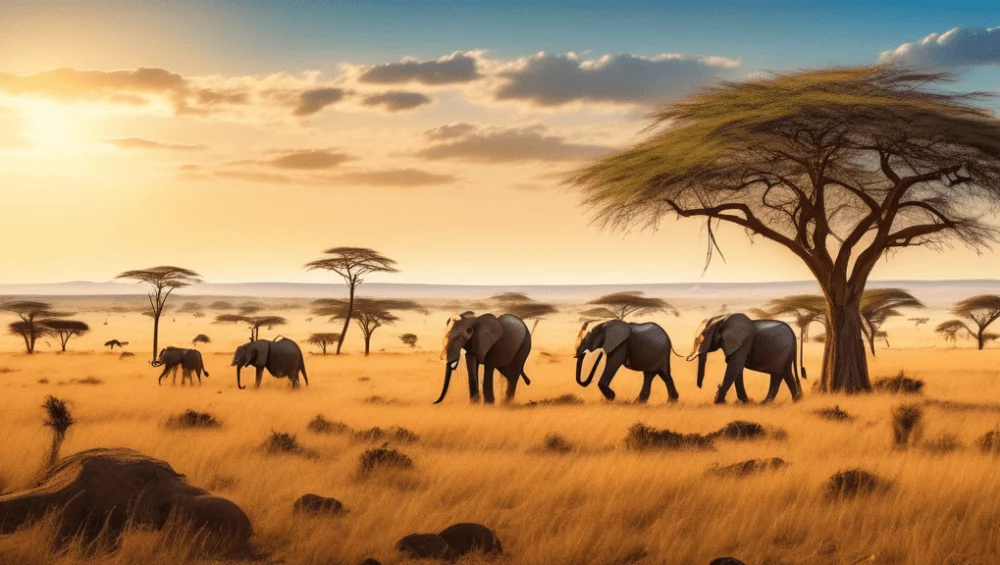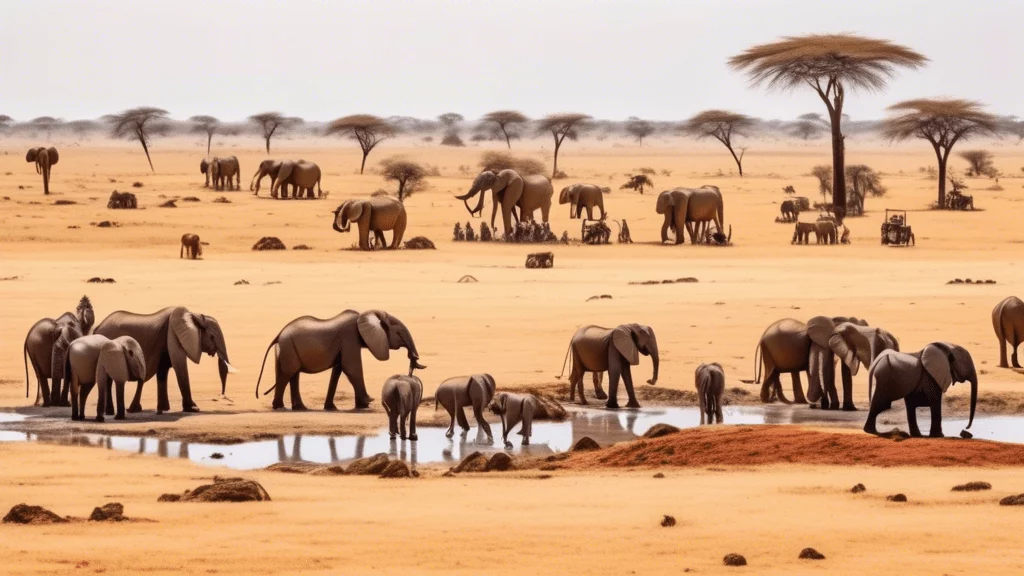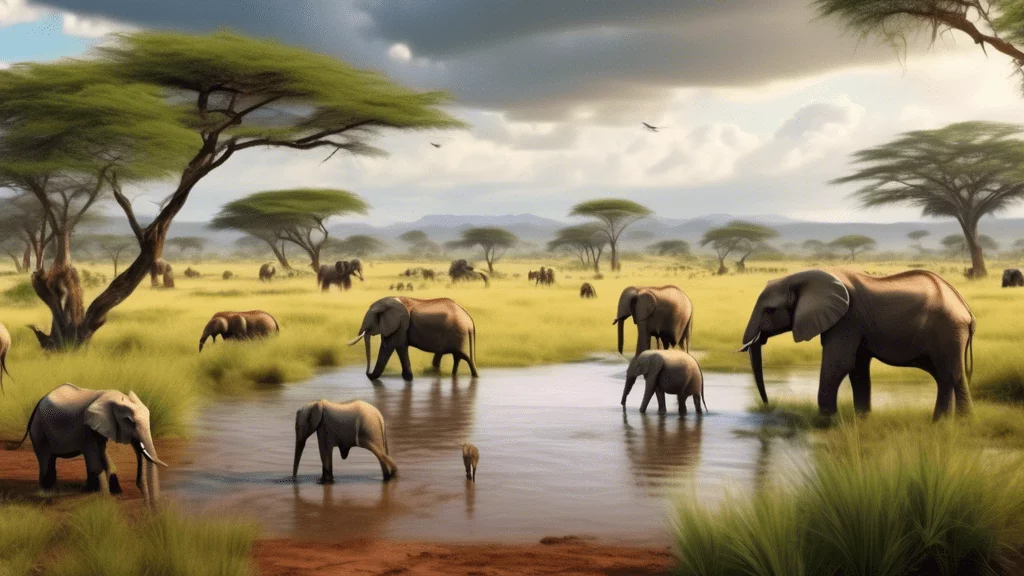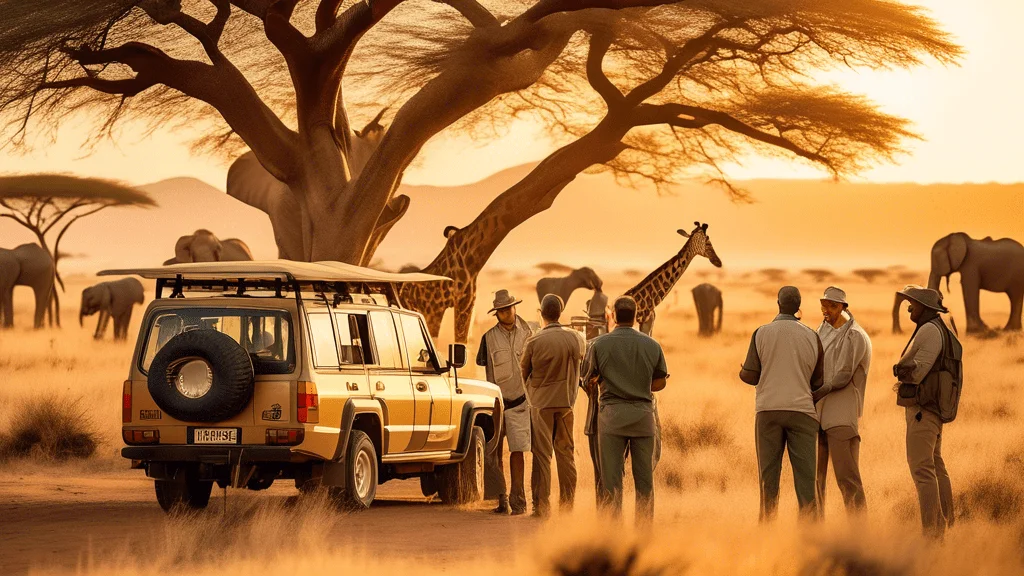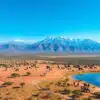Introduction to Safari Seasons
Have you ever dreamed of witnessing a lion’s powerful roar echo across the savannah at sunrise? Or maybe you’ve pictured yourself capturing the playful antics of baby elephants against a dramatic African sunset? A safari adventure can truly be a life-changing experience, but there’s one critical detail that can make or break your trip: timing. Yup, picking the right season for your safari is as crucial as packing your camera and sunscreen.
Why does timing matter so much? Well, Africa’s diverse ecosystems are deeply influenced by seasonal changes, which, in turn, affect wildlife behavior and weather conditions. If you’re new to safari planning (or even if you’re a seasoned traveler), understanding these seasonal nuances can help you spot more wildlife, enjoy comfortable weather, and get the most out of your journey. Did you know, for example, that during the dry season, animals are easier to spot as they gather around available water sources? Or that the wet season offers lush, green landscapes ideal for stunning photographs?
In this guide, we’ll take you through the best times to embark on your safari adventure, highlighting the unique advantages each season offers. From the bustling wildlife scenes during the dry months to the verdant beauty and baby animal sightings in the wet season, we’ve got you covered. So, grab your safari hat, and let’s dive into the ultimate guide to planning your perfect safari trip, no matter what time of year it is!
Introduction to Safari Seasons
Overview of the Importance of Timing for Safari Adventures
So, you’re thinking about going on a safari? That’s awesome! It’s one of those bucket-list experiences that can completely change how you see the world. But timing is everything. Trust me, just as you’d avoid a beach vacation during a hurricane season, you need to pick the right season for your safari. Not only does it affect how much wildlife you’ll see, but it’ll also determine what kind of weather you’ll be dealing with.
Last year, a friend of mine went on a safari in kenya Kenya during the wet season. She thought it would be adventurous to see the lush landscape. She wasn’t entirely wrong, but she spent most days battling mud and rain, and many animals were hiding. She learned the hard way that not all seasons are created equal when it comes to safari adventures!
Brief Explanation of How Seasons Affect Wildlife Viewing and Weather
Now, let’s get into how exactly seasons can shape your safari experience. Africa’s climate generally falls into two main seasons: the Dry Season and the Wet Season. Each of these has its unique pros and cons.
During the dry season, which usually spans from June to October, the weather is more predictable with clear skies and lower chances of heavy rainfall. The grass is shorter, and water sources are scarce, causing animals to congregate around rivers and waterholes. Perfect for that close-up lion pic, right?
Conversely, the wet season, generally from November to May, transforms the landscape into a vibrant green paradise. It’s like someone turned on the nature’s hi-def mode! While it can be a bit trickier to spot animals behind the lush foliage, this season offers its own perks like bird watching and witnessing newborn animals.
So, depending on what kind of experience you’re after, both seasons have something magical to offer. Choosing the right one requires a bit of thought and planning. Let’s dig a bit deeper into each, shall we?
Dry Season Safaris: Peak Wildlife Viewing
Description of Dry Season Conditions (Typical Months, Climate)
Picture this: it’s early morning, the air is crisp with just a tinge of chill, and the sun is starting to paint the sky in hues of gold. This romanticized picture is often painted by the dry season in many safari destinations. Typically spanning June to October, the dry season is characterized by its lack of rainfall, leading to clear skies and cooler temperatures, especially in the mornings and evenings. Sounds good so far, doesn’t it?
Temperatures can vary, but generally, you’ll get mild, pleasant weather during the day and cooler nights—a far cry from the sweltering heat that some might expect. You might want to pack a light jacket or sweater, especially for those early morning game drives. Don’t forget your sunscreen though – the African sun can be surprisingly fierce even in winter!
Advantages of Going on Safari During the Dry Season (Wildlife Concentration, Clear Visibility)
Now, let’s talk about the headliners: the wildlife. The dry season is prime time for wildlife viewing, and here’s why. During this period, water sources dwindle, driving animals to cluster around the remaining waterholes and rivers. Imagine the thrill of seeing a diverse array of species—elephants, buffalos, zebras, and lions—converging at a single spot. It’s like nature’s version of a bustling downtown café! Plus, the sparse vegetation and shorter grass make it easier to spot and photograph these magnificent creatures. Say goodbye to those frustrating “where’s Waldo”-style wildlife searches!
Take my trip to the Serengeti, for example. It was during the dry season, and I kid you not, I witnessed a herd of elephants sauntering towards a waterhole right in front of our jeep. Not to mention the pride of lions lounging under a distant acacia tree, basking in the midday sun. The clear visibility allowed me to capture these moments on camera, creating memories that still give me goosebumps.
Moreover, the roads and tracks are much more navigable during the dry season. Less mud means less chance of getting your safari vehicle stuck or having to cancel a drive due to impassable roads. All in all, it’s a stress-free and optimal viewing experience.
Top Safari Destinations During the Dry Season (e.g., Serengeti, Kruger National Park)
If your safari dreams are calling, the Serengeti in tanzania Tanzania is a must-visit during the dry season. Besides boasting some of the densest wildlife populations in Africa, the Serengeti is also famous for witnessing parts of the Great Migration, where millions of wildebeest and zebras move in search of greener pastures. The drama on display is nothing short of spectacular – think river crossings, predator-prey encounters, and more.
Another iconic destination is South Africa’s Kruger National Park. It’s an incredible place where you have a high likelihood of spotting the Big Five: lion, leopard, rhinoceros, elephant, and Cape buffalo. During the dry months, animals frequent the banks of the park’s plentiful rivers, providing spectacular sightings. Plus, the comfortable climate and excellent infrastructure make it a popular choice for first-time safari-goers and families alike.
Then, there’s Zambia’s South Luangwa National Park. Known as the birthplace of the walking safari, it offers a unique way to experience the wilderness on foot. Walking through the bush with an armed guide and tracking wildlife in their natural habitat is a thrilling experience, and the dry season makes it even better as visibility is at its peak.
So, are you feeling the excitement yet? The dry season is truly a magical time for a safari, with the perfect blend of wildlife concentration, scenic beauty, and ideal weather conditions. Trust me, once you experience a dry season safari, you’ll be reluctant to head home!
Wet Season Safaris: Lush Landscapes and Calving Seasons
Description of Wet Season Conditions
Alright, picture this: tropical rains refreshing the parched earth, transforming dusty safari trails into verdant, green pathways. The wet season typically runs from November to April in many African safari destinations. During this time, the climate is warm and humid, with regular rainfall that brings the landscape back to life.
Have you ever stood under a light drizzle and felt completely refreshed? That’s pretty much the vibe. Of course, it can occasionally be more of a downpour than a drizzle. But, hey, that’s part of the adventure, right?
Unique Experiences During the Wet Season
One word: Babies. The wet season is calving season, when a plethora of wildlife, from zebras to wildebeests, births their young. Can you imagine the sheer delight of watching a baby giraffe take its first wobbly steps? This is also the perfect time for bird enthusiasts. Many bird species migrate to African wetlands, transforming the skies with their vivid colors and melodies. It’s a bird-watcher’s paradise.
And let’s not forget the lush scenery. The landscape is at its most beautiful, veiling itself in a thick, green blanket. Fields of wildflowers spring up, painting the savannah in hues you probably thought were exclusive to rainbows. It’s like nature decided to put on its Sunday best just for you.
Plus, the photographic opportunities are simply outstanding. The contrast between the green landscape and the vibrant wildlife against dramatic, cloudy skies is a dream come true for shutterbugs.
Best Safari Locations for the Wet Season
Alright, so where should you head if you’re tempted by all this? Here are some top picks:
Okavango Delta, Botswana
First up, the Okavango Delta in Botswana. You know that ultimate oasis you’ve fantasized about? This is it—only better. The delta is a maze of waterways, islands, and floodplains, which come alive during the wet season. Navigate the labyrinth in a mokoro (a traditional dugout canoe) and become an honorary explorer. The abundant water brings more lush vegetation, attracting a wide array of wildlife.
Picture hippos basking in the shallows, crocodiles lurking ominously, and elephants taking a well-deserved bath. This place is a living, breathing Eden.
Serengeti National Park, tanzania Tanzania
Then there’s the Serengeti National Park in tanzania Tanzania. Ah, the Serengeti—home to one of nature’s greatest spectacles: The Great Migration. During the wet season, the park is teeming with life and greenery. Baby animals make their debut, while predators roam a little more freely, necessitated by the abundance of prey.
And the birds… Oh, the birds! Flamingos, storks, and a myriad of other species grace the waters, turning lakes into palettes of pink, white, and gold.
Additionally, the crowds are thinner, offering a more intimate experience. Ever had an all-you-can-watch wildlife buffet with no queues? That’s what this feels like.
Liuwa Plain National Park, Zambia
Lastly, there’s the lesser-known gem, Liuwa Plain National Park in Zambia. This park might not have the global fame of a Kruger or Masai Mara, but it sure packs a punch during the wet season. The plains turn into a floodplain, drawing large numbers of wildebeest, cheetahs, and hyenas.
It’s a spectacle not often seen, providing a unique twist on the usual safari experience. Couple this with the stunning sunrises and sunsets over the flooded plains, and you’re in for a visual treat like no other.
So, is the wet season drawing you in? It should be! With its lush landscapes, abundant wildlife (hello, baby animals!), and fewer tourists, it’s a uniquely enriching safari experience. Whether you’re an avid bird watcher, a passionate photographer, or simply someone looking to soak in Mother Nature’s finest, the wet season has something special in store.
Shoulder Season Safaris: Balancing Crowd and Comfort
Explanation of Shoulder Season
Let’s talk about the shoulder season. Ever heard of it? It’s that delightful sweet spot just between the dry and wet seasons. Typically, this period falls in the transition months and honestly, it often gets overlooked, but it’s one of the best-kept secrets in safari planning. Imagine a time when the landscapes are starting to thrive again, but you don’t have to jostle with huge crowds. Sounds ideal, right?
Benefits of Traveling During the Shoulder Season
Now, what’s so special about the shoulder season? For starters, it offers a fantastic balance of lower prices and fewer tourists. Picture this: you’re gazing upon majestic lions or towering giraffes, and there are no intrusive selfie sticks bumping into you. Heaven! Plus, the accommodation rates are often more reasonable, which means you can either save some bucks or splurge on a few more luxurious touches without blowing your budget.
One of my friends once visited South Luangwa during shoulder season. He couldn’t stop raving about it. Not only did he get to enjoy almost private game drives, but he also snagged an incredible deal on a luxurious lodge that would have been way out of his league during peak season. And let’s not forget the weather balance. It’s neither too hot nor too wet, making it perfect for both wildlife viewing and relaxation.
Have you ever worried about heavy rains ruining your trip or dust storms making things uncomfortable? Well, in the shoulder season, you get a bit of the best of both worlds. The rains, if any, are usually brief and might even enhance your experience with dramatic skies and lush green scenery without the overwhelming muck and mire.
Recommended Safari Spots During Shoulder Season
So where should you head during this magical time? Let’s dive into a couple of top spots.
Nairobi National Park, kenya Kenya
First on the list is Nairobi National Park. Yes, a safari adventure right on the city’s doorstep! During the shoulder season, this park offers a blend of the bustling city and the tranquility of wildlife. You can spot the Big Five while enjoying a backdrop of city skyscrapers – it’s surreal! Plus, fewer tourists mean you get to experience these incredible sights in a more intimate setting.
South Luangwa, Zambia
Next up, let’s talk about South Luangwa in Zambia. Here, shoulder season offers a unique opportunity. The park is renowned for its walking safaris, and during the shoulder months, the rivers begin to swell, and the landscape transforms, yet it’s still accessible enough for those on-foot excursions. Wildlife is still abundant, and trust me; there’s nothing quite like tracking animals with an expert guide in a nearly empty wilderness.
And can I let you in on a little secret? The shoulder season is also the perfect time for photography. The skies can be particularly dramatic with a mix of sunshine and the occasional cloud, giving your photos a dynamic and vibrant feel. You’ll get those classic sunny shots but with a touch of something special that only this transition period can offer.
So, next time you’re planning a safari and feeling torn between dry and wet seasons, give the shoulder season a thought. It’s an adventure that offers the best of both worlds – comfort, affordability, and an incredible experience without the overwhelming crowd.
Tips for Planning Your Safari Adventure
Essential Factors to Consider When Choosing Safari Dates
Are you dreaming of lions basking in the sun or elephants roaming the vast plains? Great! But before jumping into your khakis and grabbing those binoculars, there’s a bit of planning to do. Timing is everything when it comes to safaris. Here are some key points to ponder:
Personal Preferences: What kind of experience are you after? If you’re a wildlife photography enthusiast, the dry season might be your best bet, when animals cluster around waterholes, making them easier to spot. On the other hand, if lush landscapes and fewer tourists tickle your fancy, the wet season offers a quieter, more intimate interaction with nature. Think about what floats your boat—your safari should be a personal adventure, after all.
Budget: Let’s talk numbers. Safari adventures can vary widely in cost depending on the season. High demand during the dry season often means higher prices for accommodation and tours. Conversely, visiting during the shoulder or wet season can save you a pretty penny. More money for souvenirs, right? Weigh your budget against your desired experience to find the best fit.
Health Precautions: A safari is an adventure, but it’s not without its considerations. Are you aware of the malaria risks that are prevalent in some regions? During the wet season, mosquitoes can be more active. Packing insect repellent and consulting with a travel health specialist for any necessary vaccinations or medications is crucial. Don’t let the bugs bite—better safe than sorry!
Suggested Safari Packing List for Different Seasons
Alright, you’ve picked your perfect season. Now, what do you pack? Here’s a helpful list tailored to the different seasons:
Dry Season:
- Light, breathable clothing (think neutral colors to blend with the environment)
- Wide-brimmed hat and sunglasses (that African sun is no joke!)
- Binoculars and a good camera (for all those once-in-a-lifetime shots)
- Light jacket for early morning game drives (it gets surprisingly chilly!)
- Sunscreen and lip balm with SPF (seriously, you’ll thank me for this one)
Wet Season:
- Rain jacket or poncho (nobody likes being drenched)
- Waterproof bags for your electronics (your camera will appreciate it!)
- Quick-dry clothes and a good pair of waterproof boots (mud happens)
- Extra insect repellent (remember those pesky mosquitoes?)
- Layers, as temperatures can fluctuate unexpectedly
Shoulder Season:
- Combination of light and warm clothing (you’ll need versatility!)
- Comfortable walking shoes (for those spontaneous walking safaris)
- Travel guidebook or local flora and fauna identification book (enhance your experience!)
- A small daypack for excursions (keep your hands free for the camera)
- Personal first aid kit (be prepared, just in case)
Booking Tips and Recommended Safari Operators for Each Season
Now, onto the fantastic part—booking your safari! Here’s how you can make sure everything goes smoothly:
Research and Reviews: Nothing beats the wisdom of fellow travelers. Sites like TripAdvisor or SafariBookings offer detailed reviews on safari operators. Consider reaching out to past clients via travel forums to get the down-low on their experiences. They might have tips that no guidebook can offer.
Early Bird Gets the Worm: Especially true during the dry season, when demand is high. Booking your safari well in advance ensures that you get the best lodges and experienced guides. Plus, it gives you ample time to pack wisely and get those critical vaccinations.
Off-Peak Perks: If you’re traveling during the shoulder or wet seasons, there are deals to be had! Many operators offer discounted rates during these times, which means you can stretch your budget without sacrificing quality. Consider operators who have glowing reviews for off-peak travel, ensuring they can deliver an exceptional experience regardless of the season.
Personal Recommendations: From personal experience, I can vouch for the Kruger National Park safaris during the dry season. I’ve seen wildlife practically parading around! For the wet season, the Okavango Delta safaris were a dream—picture perfect landscapes and baby animals galore. And if you’re eyeing the shoulder season, Nairobi National Park offers a fantastic blend of wildlife viewing and easy accessibility. The key is to match the destination with the season, creating the ideal conditions for your adventure.
Your safari dream is within reach with these tips and considerations to guide you. So, where will your adventure take you? 🦁
Conclusion
So, when is the best time to go on safari? Well, much like choosing between chocolate and vanilla, it’s all about personal preference. The dry season is a clear winner if your heart is set on seeing lions, elephants, and all those iconic animals gathered around waterholes like they’re having a neighborhood BBQ. And let’s not forget the perfect photo ops with the unobstructed views.
But hey, there’s something magically immersive about the wet season too. Picture this: you’re surrounded by verdant greenery, the air fresh, and with the added bonus of baby animals galore. Plus, if you’re a bird enthusiast, it’s like Christmas came early with all those migratory species showing off their plumage.
If you want to dodge the crowds but still catch some great wildlife action, the shoulder season is your goldilocks zone—just right. You’ll find more manageable prices and fewer tourists, making it a sweet spot for both your wallet and your peace of mind. Places like Nairobi National Park or South Luangwa are quieter but just as thrilling.
Now, before you grab your camera and khaki attire, remember to consider your own preferences and budget. Do you want high energy and lots of animal sightings? Dry season might be more your style. Prefer a quieter, more intimate experience with lush landscapes? Wet season it is. And if you’re after a balanced adventure without the heavy crowds, shoulder season won’t disappoint. Pack smart, plan ahead, and choose a reliable safari operator tailored to your chosen season.
In the end, every safari has its unique charm. Whether you’re marveling at a great migration in the dry season, savoring the splendor of calving season in the wet months, or enjoying the serenity of shoulder season, the adventure is bound to be unforgettable. So, keep your binoculars handy, your sense of adventure alive, and go create those safari memories!

